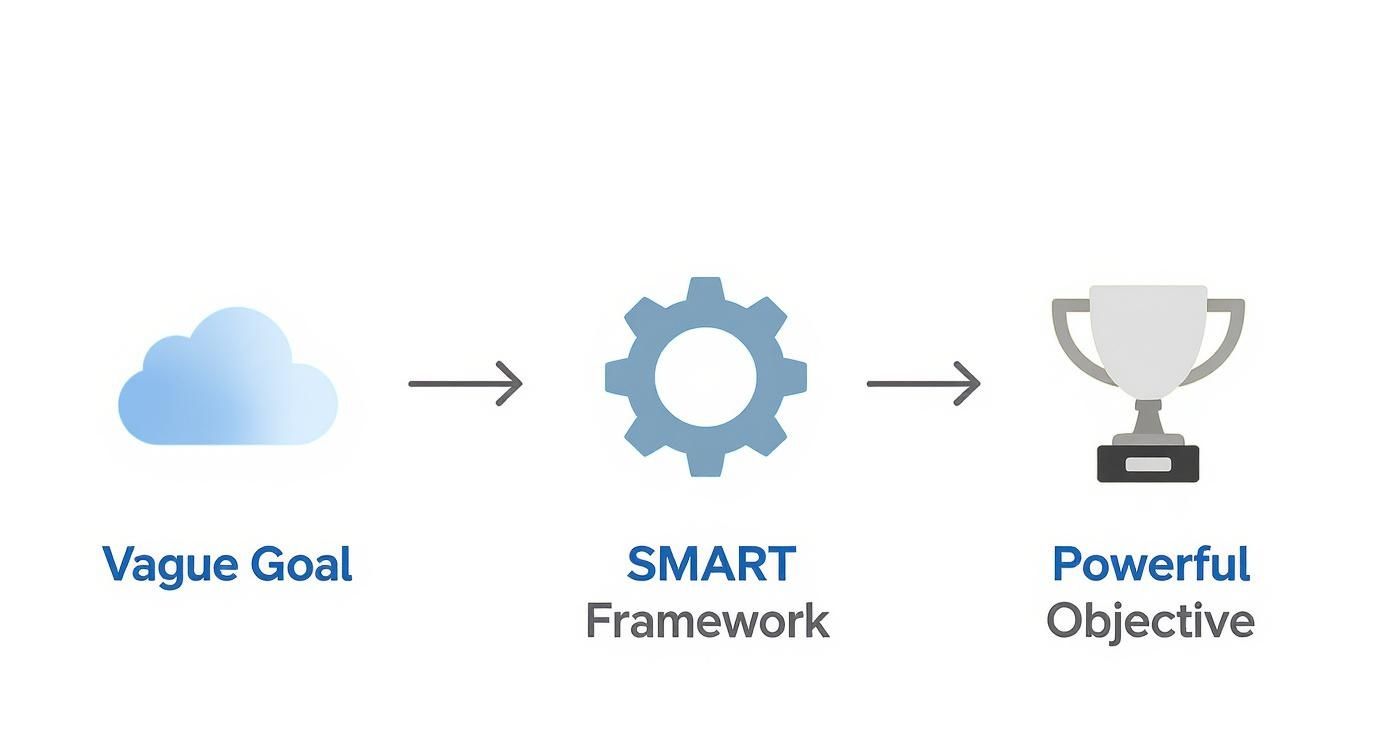Let’s be honest: most documents we call "action plans" are really just glorified to-do lists. They start with the best intentions—a burst of brainstorming, a flurry of tasks—but they lack the strategic glue to hold everything together.
A week or two later, where do they end up? Buried in a shared drive, forgotten. The initial momentum is gone, and everyone’s back to business as usual.
Moving Beyond the To-Do List
This happens because a simple list of tasks fails to connect the dots between daily work and the bigger picture. It doesn’t create alignment, clarify what’s truly important, or give the team a shared sense of purpose. For fast-paced agencies and professional services teams, this is a recipe for stalled projects and frustrated people.
A real action plan is a strategic tool, not just a checklist.
Why Most Action Plans Fail
So, what separates a plan that drives action from one that gathers digital dust? It comes down to a few critical components that are surprisingly easy to miss. Most plans fall apart because of these common mistakes:
- Vague Goals: Objectives like "improve client satisfaction" sound nice but are impossible to act on. There's no clear finish line, so no one knows what they’re actually running toward.
- Lack of Ownership: When a task is assigned to "the team," it's really assigned to no one. Without a single person accountable, it's easy for everyone to assume someone else has it covered. This is probably the #1 reason things get dropped.
- No Team Buy-In: If the people doing the work aren’t involved in creating the plan, they have zero investment in its success. It just feels like another top-down directive instead of a shared mission.
- Zero Review Cadence: A plan is outdated the moment it's finalized. Without a regular check-in, there’s no way to adapt to new challenges, pivot when something isn't working, or even celebrate small wins along the way.
To turn a simple list into a powerful plan, you need to bake these core components in from the start.
Core Components of an Effective Action Plan
This table breaks down the essential elements that transform a static to-do list into a dynamic, strategic action plan that actually gets results.
| Component | Why It Matters for Your Team | Example in Practice |
|---|---|---|
| Specific, Measurable Goals | Vague goals lead to vague efforts. Clarity ensures everyone is working toward the same, well-defined outcome. | Instead of "Improve SEO," the goal is "Increase organic traffic to our blog by 15% in Q3." |
| Actionable Steps | This breaks the big goal down into manageable pieces, preventing overwhelm and making it clear what to do next. | To increase traffic, steps include: "Publish 4 new keyword-optimized articles per month." |
| Clear Ownership | Assigning one person to each task eliminates confusion and creates accountability. Everyone knows who to go to. | "Anna is responsible for keyword research. David is responsible for writing the first draft." |
| Realistic Timeline | Deadlines create a sense of urgency and help with resource planning. Without them, tasks expand to fill the time available. | "First draft of Article 1 is due by EOD Friday." |
| Defined Success Metrics | You can't improve what you don't measure. KPIs tell you if you're on track or need to adjust your approach. | "Track monthly organic sessions in Google Analytics and keyword rankings in Ahrefs." |
| Review Cadence | Regular check-ins keep the plan alive. It's a chance to adapt, solve problems, and maintain momentum. | "A 15-minute sync every Monday morning to review progress and identify blockers." |
Think of these components as the architecture of your plan. Without them, you’ve just got a pile of bricks with no blueprint.
The Global Push for Structured Planning
The need for this kind of structured, systematic planning isn't just a business best practice—it’s a globally recognized framework for achieving huge goals. Just look at the widespread adoption of national action plans.
As of November 2023, a staggering 178 countries had finalized their National Action Plans to meet global objectives, with 38 more in development. This shows a universal understanding that a clear, systematic framework is the only way to turn ambitious goals into reality. You can learn more about how countries implement national action plans and monitor their success.
An action plan isn't a document you create once and forget. It's a living, breathing guide that aligns your team, clarifies what truly matters, and connects every task back to your most important business goals. It's the engine for real momentum.
Nailing Down Your Strategic Objectives
An action plan without a clear "why" is just a to-do list. To build a plan that actually creates momentum, you have to anchor it to a meaningful, strategic business objective first. This is the North Star that guides every decision, task, and dollar you spend from here on out.
Skip this step, and you get busywork. Teams complete tasks and hit small deadlines, but all that collective effort doesn't move the needle on what truly matters to the business. It’s the difference between running on a treadmill and running a marathon with a finish line in sight.
Beyond Generic Goals
You've heard of the SMART framework—Specific, Measurable, Achievable, Relevant, and Time-bound. It’s a solid foundation, but too often, agencies stop at the surface, creating goals that are technically SMART but lack any real punch.
A goal like "Improve client happiness" is just too vague. A slightly better version is "Increase client satisfaction by 10% this year." Sure, it's measurable, but it still doesn't give your team a clear target to aim for.
Let's ground this in a real-world agency scenario. How do you actually measure "happiness"? One of the most powerful metrics out there is the Net Promoter Score (NPS). Using that, a truly strategic objective looks like this:
"Increase our average client Net Promoter Score (NPS) from a 7 to a 9 by the end of Q3 by revamping our onboarding and quarterly review processes."
Now that's an objective. It defines the outcome (NPS of 9), sets a deadline (end of Q3), and even points to the strategy required to get there (overhauling onboarding and reviews). It gives your team immediate, concrete direction. For a deeper dive into this, check out our guide on the essential steps to set the perfect goals for your business.
Get Your Key People in the Room
One of the biggest mistakes leaders make is defining these objectives in a vacuum and then handing them down to the team. This approach is a fast track to zero buy-in. The people who have to execute the plan need a seat at the table when it's being created.
This isn't just about making people feel included—it’s about tapping into crucial, on-the-ground intelligence. Your account managers know exactly what frustrates clients. Your creative leads know where the production bottlenecks are. You need their insights.
Here’s a practical way to get everyone involved:
- Set the Stage: Leadership kicks things off by identifying the broad strategic priority. For example, "We need to improve client retention."
- Host a Workshop: Pull together leads from different departments—account services, creative, project management—for a real brainstorming session.
- Ask the Right Questions: Guide the discussion with questions like, "What are the top three reasons we lose clients?" or "If we could change one thing to improve the client experience, what would it be?"
- Draft the Objective Together: Use the raw insights from the workshop to collaboratively shape a specific, measurable objective, just like the NPS example above.
Following this process ensures the final objective isn't just a lofty corporate goal, but something that’s deeply rooted in the team's day-to-day reality.
From Objective to Ownership
When your team helps build the objective, they feel an immediate sense of ownership. That account manager who flagged issues with the onboarding process? They're going to be far more invested in a plan designed to fix it. They understand the "why" because they helped write it.
This shared purpose is the fuel for any successful action plan. It means that when challenges pop up—and they always do—the team is united in finding solutions, not pointing fingers. They can draw a straight line from their individual tasks to a goal they actually believe in.
The difference is night and day:
| Top-Down Objective | Collaborative Objective |
|---|---|
| Feels like a directive from on high. | Feels like a shared mission. |
| The "why" is often vague or abstract. | The team sees the direct link to their work. |
| Motivation is based on compliance. | Motivation is driven by genuine investment. |
| Resistance to change is the default. | Team members become champions for change. |
Before you map out a single task, dedicate real time to defining your strategic objective with the right people. This foundational step is the single most important factor in whether your action plan drives real results or just gathers dust in a forgotten folder.
Breaking Down Goals Into Actionable Steps
So you've hammered out a powerful, collaborative objective with your team. Awesome. But now comes the hard part: turning that high-level vision into something you can actually do on a Monday morning.
A big goal, like "Launch a new client onboarding process," can feel completely overwhelming. It's so massive that nobody knows where to start. This is where procrastination creeps in, and momentum dies before the project even gets off the ground.
The only way forward is to break it down. You have to deconstruct that intimidating objective into a series of small, concrete, manageable tasks. This simple act transforms a vague idea into a clear roadmap, giving your team a sense of progress that keeps everyone motivated.
This flow chart shows exactly how a fuzzy idea becomes a real, actionable objective when you apply a little structure.
As you can see, getting from a concept to a concrete plan isn't magic; it's a deliberate process of adding clarity and structure.
The Work Breakdown Structure in Action
A work breakdown structure (WBS) is a classic for a reason—it’s a straightforward but incredibly powerful way to deconstruct a project. You start with the main objective at the top, then slice it into smaller components until you're left with a list of individual tasks you can assign and schedule.
Let's stick with our agency example: Launch a new client onboarding process.
Breaking this down isn't just about making a random to-do list. It's about thinking through the entire project lifecycle, from initial research all the way to the final rollout.
Initial Breakdown (Major Phases):
- Phase 1: Research and Discovery
- Phase 2: Process Design and Documentation
- Phase 3: Asset Creation
- Phase 4: Internal Training and Rollout
That’s a decent start, but "Process Design" still isn't a task someone can do. We need to go deeper.
Detailed Task Breakdown (Actionable Steps):
- From Phase 1 (Research):
- Survey all account managers on current onboarding pain points.
- Interview 3 recently onboarded clients for feedback.
- Analyze support tickets related to new client questions from the last 6 months.
- From Phase 2 (Design):
- Draft V1 of the new onboarding project plan template.
- Define key milestones for the first 30, 60, and 90 days of a client engagement.
- Create a standardized internal kickoff meeting agenda.
- From Phase 3 (Assets):
- Write copy for standardized welcome email templates.
- Design a "New Client Welcome Kit" PDF.
- Record a short video tutorial on how to access the client portal.
- From Phase 4 (Rollout):
- Schedule and conduct internal training for the account management team.
- Update the company's internal knowledge base with the new process docs.
- Select one new client to pilot the process before a full launch.
Just like that, a massive, intimidating project feels entirely doable. Every bullet point is a clear, specific action that someone can own and complete.
Mapping Dependencies and Estimating Resources
Having a list of tasks is only half the battle. The next critical step is figuring out how they all connect. For instance, you can't draft the new onboarding checklist (a Phase 2 task) before you've surveyed the team on their pain points (a Phase 1 task). This relationship is called a task dependency.
Mapping these dependencies is how you avoid the classic bottlenecks that derail projects. It forces you to do the right work in the right order.
- Identify Predecessors: For each task, simply ask, "What needs to be finished before this can possibly start?"
- Estimate Time: Get realistic about how many hours or days each task will take. Don't just guess—pull in the people who will actually do the work. Their experience from the trenches is invaluable for getting this right.
- Assign Resources: Figure out who you need for each task and what else is required (software, budget, a designer's time). This is where you find out if your team actually has the bandwidth to pull this off.
Laying out dependencies and resources turns your task list into a true project plan. It allows you to build a realistic timeline and identify potential resource gaps before they become full-blown crises.
For agencies juggling multiple client projects, creating a comprehensive project management work plan is the only way to keep all these moving parts organized and on track.
From Breakdown to Execution
Once you have your goals broken down into these clean, actionable steps, it’s a great time to think about business process optimization. This is where you can refine those newly defined tasks, trim out any redundancies, and make sure the whole workflow is as smooth as possible.
It’s not just about getting the tasks done, but getting them done in the smartest way possible. By carefully deconstructing your big objectives into these small, interconnected steps, you build the solid foundation for an action plan that actually works—and moves your team from feeling overwhelmed to feeling empowered.
Assigning Ownership and Integrating with Calendars
An action plan with vague responsibilities is a plan destined to fail. Even the most perfectly crafted task list is useless if no one knows who’s supposed to do the work. This is the exact spot where so many great plans fall apart—not from a lack of good ideas, but from a total lack of clear ownership.
Every single task needs a name next to it. Simple as that. When you assign a task to "the team," you're really assigning it to no one. That ambiguity creates a dangerous diffusion of responsibility where everyone assumes someone else has it covered. And you know what happens next? Nothing.
The Power of a RACI Chart
To kill that confusion dead in its tracks, you can use a simple but incredibly powerful tool called a RACI chart. RACI stands for Responsible, Accountable, Consulted, and Informed. It's a straightforward matrix that clarifies everyone's role and makes sure every task has a definite owner, preventing things from slipping through the cracks.
Here’s how it works for each task in your plan:
- Responsible: This is the person who actually does the work. They're the one executing the task.
- Accountable: This is the person who owns the work. They have the final say and are ultimately answerable for its success or failure. Crucially, there should only be one "A" per task.
- Consulted: These are your subject matter experts who provide input. You have a two-way conversation with them before a decision is made.
- Informed: These are the people you keep in the loop. It’s a one-way street—you're just updating stakeholders on progress after an action is taken.
Let's look at our "New Client Onboarding Process" project. For the task "Draft V1 of the onboarding checklist," a RACI chart might look like this:
| Role/Name | R (Responsible) | A (Accountable) | C (Consulted) | I (Informed) |
|---|---|---|---|---|
| Sarah (Project Manager) | R | I | ||
| David (Account Director) | A | |||
| Anna (Account Manager) | C | I | ||
| CEO | I |
In this scenario, Sarah is doing the drafting, but David is the one who's ultimately accountable for its quality. Anna provides her frontline insights, and the CEO is simply kept informed. This simple grid removes all the guesswork.
Turning Your Plan into a Living Workflow
Once ownership is crystal clear, the next move is to get your action plan out of a static document—like a spreadsheet or slide deck—and into your team’s daily workflow. The absolute best way to do this is by plugging it directly into their calendars.
A task list sitting in a project management tool is still something your team has to remember to check. A task scheduled on their calendar? That’s something they can’t ignore. It becomes a tangible commitment, a block of time they've dedicated to making real progress.
This is where a tool like TimeTackle becomes the central hub for seeing what your team is up to and making sure those action plan items are baked into their daily schedules.
The key insight here is visibility. When tasks live on the calendar, managers can see exactly where time is allocated. Team members can plan their days around actual priorities, not just react to whatever feels most urgent in the moment.
An action plan on a calendar is no longer a set of intentions; it's a series of appointments with progress. This simple shift dramatically increases the likelihood that the work will actually get done.
Platforms like TimeTackle are built for this exact purpose. They can automatically sync tasks from your project management system, like Asana, directly onto your team members' Google Calendars. For agencies that live and die by their calendars, the value of an Asana to Google Calendar integration is immense. It transforms a project plan from a separate, disconnected system into an active part of each person's daily schedule.
This kind of integration ensures that deadlines, responsibilities, and dedicated work blocks are always visible and top-of-mind. It’s the final, crucial link between planning and execution, making your action plan an unavoidable—and central—part of the daily grind.
Tracking Progress with KPIs and Review Meetings
So, your action plan is built, tasks are neatly assigned, and everyone’s calendar is synced up. Great. But the real work starts now.
This is where you turn a static document into a living, breathing guide for your team. Without a solid system for tracking progress and course-correcting along the way, even the most brilliant plan will eventually gather dust. It’s all about measuring what matters and creating a rhythm of accountability.
Think of it this way: your action plan is the roadmap, but regular check-ins are how you make sure you’re still heading toward your destination and haven't taken a wrong turn.
Setting Meaningful Key Performance Indicators
To actually know if your plan is working, you have to track outcomes, not just task completion. Checking boxes feels good, but it doesn't mean you're hitting your strategic objective. This is where Key Performance Indicators (KPIs) come in. KPIs are the specific, quantifiable signposts that tell you you're making real progress.
For an agency, a weak metric is something vague like "complete all onboarding tasks." A much stronger, outcome-focused KPI would be "Reduce project kickoff time by 2 business days" or "Achieve a 95% completion rate on onboarding tasks within the first week." See the difference? These are tied directly to the business impact you're trying to make.
If you’re just getting started, a crucial first step is choosing the right KPIs for your business.
A good KPI tells a story about your progress. It answers the question, "Are our actions creating the result we intended?" If you can't answer that with your metrics, you're tracking the wrong things.
The power of having a structured plan with clear metrics isn't just theory; it's proven on a global scale. Take the Marrakech Action Plan for Statistics. By March 2014, an incredible 86.6% of International Development Association countries had either completed or designed a National Statistics Development Strategy. This is a massive testament to how a formal plan provides the framework needed to systematically improve and measure success. You can see more details and discover how action plans drive measurable progress on the World Bank's site.
Establishing a Consistent Review Cadence
Once you've got your KPIs locked in, you need a regular forum to actually talk about them. This is what review meetings are for. These aren't about micromanaging—they're about collaborative problem-solving, celebrating wins, and making smart adjustments to keep the plan on track. The trick is to find a rhythm that builds accountability without burning everyone out with meeting fatigue.
Here are a few cadences I've seen work really well for agency teams:
- The Weekly 15-Minute Stand-Up: This is a quick, high-energy check-in focused on just three things: What did you get done last week? What are you tackling this week? What’s standing in your way? It's perfect for keeping the momentum going on fast-moving projects.
- The Bi-Weekly Tactical Review: A 30-minute meeting to dig into the KPI dashboards and discuss task progress. This is less about individual status updates and more about analyzing the data. Are we trending in the right direction? If not, why?
- The Monthly Progress Review: A 60-minute session with key stakeholders. Here, you zoom out to look at the bigger picture. It's the time to celebrate major milestones, unpack significant challenges, and make strategic calls about the plan itself.
Making Your Meetings More Effective
The entire point of these meetings is to drive action, not just to talk.
To make sure they stay productive, stick to a few simple rules. First, always have a clear agenda that’s laser-focused on the KPIs and any known roadblocks. Second, make sure performance data is shared beforehand so everyone comes to the meeting ready to discuss, not just to see the numbers for the first time.
And finally, end every single meeting with clear action items. Who is responsible for what, and by when? This simple habit creates a powerful feedback loop, ensuring the insights from your reviews translate directly back into your action plan. It’s what keeps your team aligned and consistently moving forward.
Common Questions About Action Plans
Even with the best framework in place, you’ll inevitably run into questions once you’re in the trenches. Let's tackle some of the most common ones we hear from agency teams trying to put their plans into motion.
What Is the Difference Between a Strategic Plan and an Action Plan?
Think of it this way: your strategic plan is the destination you plug into your GPS. It’s the high-level vision—the what and the why. It answers the question, "Where are we going?"
Your action plan is the turn-by-turn navigation. It’s the ground-level roadmap detailing the who, what, and when to get you there.
Imagine your agency's strategy is to become the top choice for B2B tech companies in your region. That's the destination. The action plan would be the detailed itinerary of specific marketing campaigns, sales outreach sequences, and operational improvements needed to make that happen. One without the other is useless; strategy provides direction, but the action plan creates momentum.
How Do You Keep a Team Motivated to Follow the Plan?
Motivation isn't about rah-rah speeches or dangling a carrot. When a team seems disengaged from a plan you spent weeks creating, it almost always boils down to one of three things: clarity, ownership, or progress.
- Clarity on Impact: Everyone on the team needs to see a straight line from their daily tasks to the big-picture goal. When a junior designer knows that the "welcome kit" they're creating is a key part of raising the client NPS score, their work suddenly has a much deeper meaning.
- A Sense of Ownership: People will always support what they help create. If you bring your team into the planning process early, letting them help define the steps and set realistic timelines, the plan becomes a shared mission—not just another top-down directive.
- Visible Progress: Small wins are a powerful fuel. Your regular check-ins shouldn't just be about what's late. Take the time to highlight completed milestones. It proves to everyone that their collective effort is actually moving the needle and builds the energy needed to tackle the next phase.
What Should You Do When an Action Plan Goes Off Track?
First off, take a breath. No plan survives first contact with reality completely intact. The goal isn't to forge an unbreakable plan but to build a resilient one. When you hit a roadblock, the first step is to diagnose the problem, not to point fingers.
Is a specific timeline proving to be completely unrealistic now that you're in it? Are key people stretched too thin between this internal project and urgent client work?
Treat your action plan as a living document, not something carved in stone. Its real value is in its ability to adapt.
This is exactly why those regular review meetings are so critical. They're your built-in system for course correction. Regroup with the team, adjust priorities, reallocate a few resources, or modify deadlines based on what you know now. It's far better to catch a small deviation early than to let it become a major derailment.
How Important Is Stakeholder Buy-In During Implementation?
Let's be blunt: stakeholder engagement isn't a "nice-to-have." It's a direct predictor of whether your plan will succeed or fail. A plan that looks perfect on paper can completely unravel if the key people who need to be involved aren't invested in the outcome.
Research consistently shows that successful plans require strong coordination and sustained collaboration with all parties. This is especially true when senior-level reviews are needed to clear roadblocks or address challenges. One study found that this level of engagement directly correlates with higher completion rates and better results. You can read more about the findings on implementing global action plans to see how this plays out on a massive scale.
The principle holds true whether you're coordinating national policy or just trying to launch a new agency-wide process. Without buy-in, you're just pushing a boulder uphill.
Ready to transform your action plans from static documents into dynamic, calendar-integrated workflows? TimeTackle provides the visibility and automation your team needs to stay aligned and execute flawlessly. See how you can connect your team's daily activities to your biggest strategic goals. Learn more and get started at https://www.timetackle.com.






